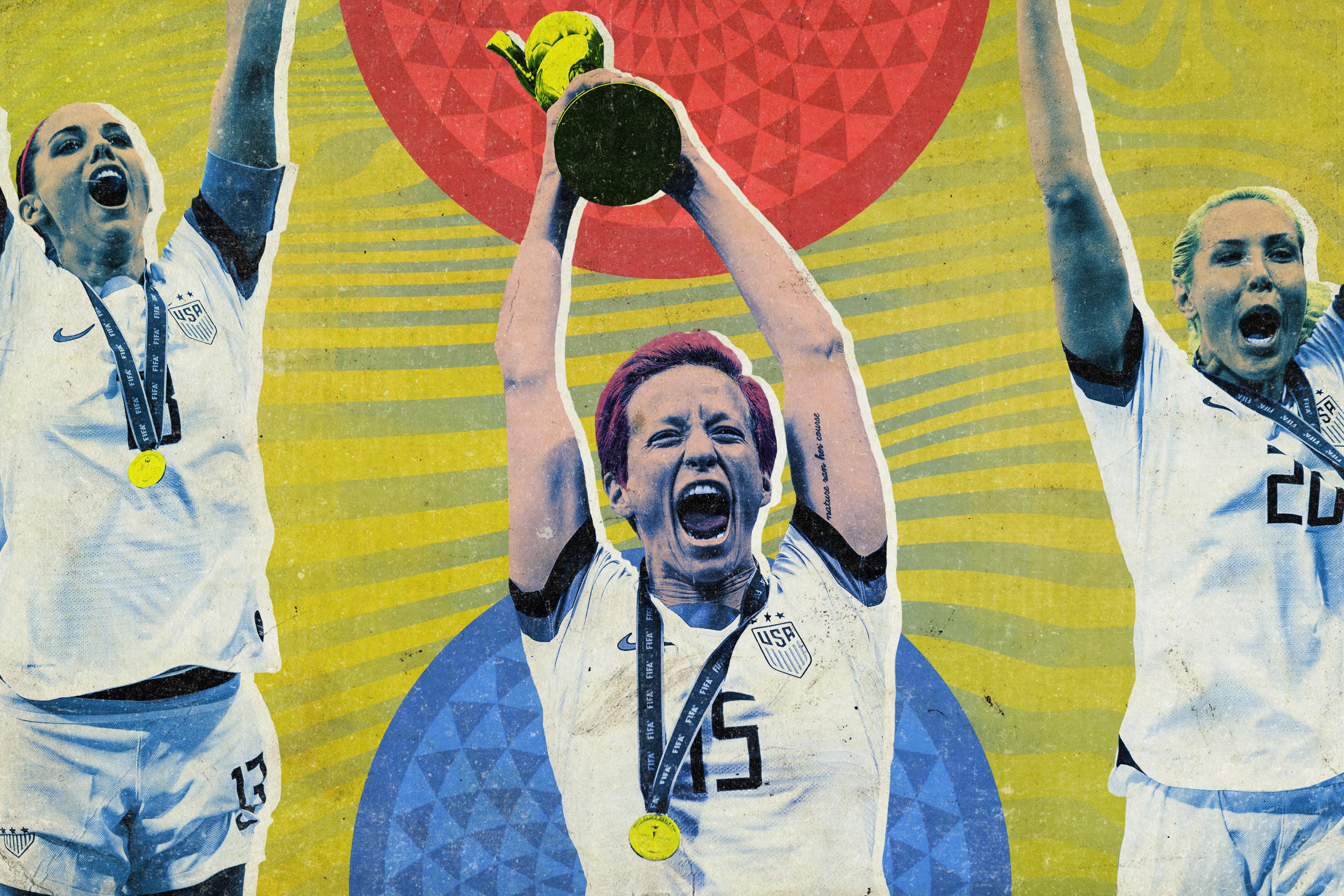The Year the USWNT Wouldn’t Stop Winning
America’s women delivered a World Cup performance for the ages this summer. It was only a small part of their impact in 2019.
Imagine what it must be like to become the best in the world at something, only to find out that being the best isn’t enough for some people. Imagine spending your entire life working to reach the pinnacle of your field and silence the haters, only for those haters to keep attempting to belittle your accomplishments even after you made it. Imagine listening to people try to undermine your success by saying that your competition was weak, or that your field is unpopular and irrelevant, or that you went about things in the wrong way. What would you do upon realizing that there are some people who simply can’t be pleased, even if you manage to be the best you can be—the best anybody in the world can be?
This was a problem that America’s women’s national soccer team faced in 2019, but not a new one—those women didn’t just become the best in the world. They have been ranked no. 1 in the FIFA world rankings for most of the past 12 years, with Germany briefly moving in front for three short stints. They have won four of six Olympic soccer tournaments and four of eight World Cups. In 664 matches all time, they have outscored their opponents by a combined total of 1,616 goals. Victory is their resting state.
In fact, what set this team apart was not that it won the World Cup, but that it won the World Cup again. Although this was the USWNT’s fourth title, this summer marked the first time the Americans had entered the event as defending champs and repeated. Their 5-2 win over Japan in the 2015 final was the most-watched soccer game in American history. This time around, they had a target on their backs, and the rest of the world showed up eager to take them down. The competition was supposedly better than ever, and so they took great joy in dodging every ax hurled at their bull’s-eye.
From start to finish, their World Cup showing was a triumph. It began with a 13-0 demolition of Thailand, a breathtaking glimpse of what it looks like when the best players in a sport get to do basically whatever they want for the full length of a game.
It culminated with a 2-0 win over the Netherlands and a multi-continental drinking spree, the latter of which was documented by goalkeeper Ashlyn Harris in what is to Instagram Stories what Citizen Kane is to cinema.
Their victory was total. The Americans set Women’s World Cup records for goals (26) and goal differential (plus-23). They never trailed, and scored within the first 15 minutes of every match except the championship. They became the first team to go 7-0-0 in the Women’s World Cup. (Team USA went 6-0-0 in the inaugural edition in 1991, back when the event was called the “World Championship for Women’s Football for the M&M’s Cup,” because FIFA wanted the words “World Cup” to be reserved for men.) They were everything the best teams can be: dominant in routs and unshakable in crunch time; confident they would win and yet utterly thrilled when they did; individually brilliant but cohesive. At times, each American player was better than each player on the opposing team. That could’ve felt cruel. With the U.S., it felt like a celebration of excellence.
Along the way, though, the women encountered a stunning amount of domestic backlash against a team coasting to victory in international play. They were criticized for scoring too much, or celebrating too hard. They were called unpatriotic, even as they won a major competition on America’s behalf. When the players had the gall to propose they should be paid as much as the American men’s soccer team, they were told that they didn’t deserve it, because they were less popular, even as they achieved greater successes in front of larger audiences. It seemed there was nothing this team could do that wouldn’t make a large portion of the population angry.
Least bothered by all of this: the women of Team USA. They were followed by a cavalcade of pointless yelling virtually everywhere they went, like dust following Pig-Pen. And still they thrived. They not only returned to the peak of their sport, but also found time to laugh at those who couldn’t find joy in their success. And instead of letting the worst arguments against them put a damper on their title, they refocused that conversation to a meaningful end.
There were plenty of things one could rightfully criticize Team USA for during this year’s World Cup. There is no reason a roster as talented as this one should have played in three consecutive one-goal games in the knockout stages. But head coach Jill Ellis—the subject of a 2017 player coup, the bane of soccer Twitter, and, thankfully, now a retiree—seemed determined to leave some of her best players on the bench, or else use them in unusual circumstances. Goalkeeper Alyssa Naeher proved an excellent shot-blocker, but sometimes passed the ball directly to opposing attackers. And the team got the benefit of questionable refereeing decisions against Spain (that penalty call!), France (that non-penalty call!) and England (that offside VAR decision!), winning each match by one goal. The U.S. was plainly the best team in the field, but appeared strangely interested in keeping their knockout matches competitive.
These weren’t major talking points. Shockingly, no right-wing bloggers tried to hit it big with posts like, “Does Jill Ellis’s Decision to Leave Lindsey Horan Out of the Starting XI Prove That She Hates America?” Instead, the most common anti–Team USA talking point focused on celebrations. When the U.S. women responded to that criticism by replacing their over-the-top celebrations with muted ones, they were criticized for that too. It continued even after they won. I’d say it’s generally a good thing in life if people’s biggest problem with you is that you celebrate too hard.
The harshest criticisms were reserved for Megan Rapinoe, the team’s boldest star. Simultaneously a masterful creator on the left wing and an unshakable closer from the penalty spot, she led all players in the tournament with six goals and 27 passes completed into the penalty area (nobody else in the tournament had more than 16). And she did this despite sitting out two of America’s seven games. She won the Golden Boot given to the World Cup’s top scorer, the Golden Ball given to the event’s best player, and the 2019 Ballon D’Or given to the best player in the world. (I don’t know how French people differentiate between the Golden Ball and Ballon D’Or, but that’s beside the point.) Rapinoe had both of America’s goals in the round of 16 against Spain, both of the team’s goals in the quarterfinals against France, and scored in the final against the Netherlands. Let’s see the pose.
And yet Rapinoe was regularly lambasted. There was the outrage over her saying that she wouldn’t visit the White House if she was invited, joining the long list of Americans who Trump supporters must virulently hate even if they bring glory to America. After winning the title, she was accused of stomping on the American flag in postgame celebrations. (A more realistic interpretation of what happened: Rapinoe maybe, kinda grazed a flag that she didn’t seem to realize was on the ground, in between celebrating with various other, not-on-the-ground flags.) It got to the point where she was even criticized for standing silently during the national anthem—which … I thought was OK? Isn’t that what 90 percent of us do at sporting events? Isn’t that considered respectful?
Rapinoe never seemed fazed by the criticism. She didn’t ignore it, like many prominent athletes who claim to do so. She went and dominated the biggest stage in her sport, and then gave honest and striking answers when asked about any topic. She used her Ballon D’Or platform to encourage male stars to fight racism and sexism in sports. She used her Sports Illustrated Sportsperson of the Year acceptance speech to call out the lack of diversity in media. She spoke with conviction and clarity about how the president of the United States targets non-white and LGBTQ citizens. (The team never did go to the White House, by the way.)
The women of Team USA refocused the conversation around them to their yearslong attempt to get paid as much as America’s male soccer players. They talked about the pay gap loudly and relentlessly. This was so effective that crowds chanted “EQUAL PAY” in World Cup stadiums and booed the head of U.S. Soccer at public events held to celebrate the World Cup win.
The argument against equal pay is always that the men’s team is simply more popular. In 2019, that was clearly untrue. This goes beyond just the discrepancy in success, as the American women are back-to-back World Cup champs while the men failed to qualify for the last World Cup and recently lost to Canada for the first time in 34 years. A fun experiment is to go to U.S. Soccer’s YouTube page and look at the view counts for recent videos about the men’s and women’s teams. A video from the account’s “Behind the Crest” series about a September USWNT friendly got 75,000 views; a video in the series posted the same day about the USMNT playing Mexico—their archrivals!—got less than 7,000. The Women’s World Cup final drew 16 million viewers despite airing at 11 a.m. Eastern time; the men’s team playing in the Gold Cup final the same day got 9 million viewers in prime time. (I also suspect many viewers were watching to see Mexico.) Jersey sales for the women’s team were the most purchased of any national team in American history, regardless of gender. The men’s team routinely played in front of fewer than 15,000 fans; the women’s team broke a record by playing in front of almost 50,000 and routinely played in front of 30,000. The women’s team, uh, generated more revenue than the men. There is no conceivable metric by which somebody could look at the U.S. men’s national soccer team and the U.S. women’s national soccer team and conclude that more people cared about the men than the women in 2019.
The USWNT succeeded on the field in spite of the way U.S. Soccer treated it. And the women harnessed the attention that came with their on-field greatness to draw eyes toward how unfairly they were treated. The team still hasn’t won its fight for equal pay—a trial is set for May—but its ability to shift the focus to that movement goes beyond just a few soccer players potentially increasing their paychecks. The USWNT are far from the only women in this country who get paid less than men who do the same jobs. But given that their achievements, popularity, and revenue are publicly available alongside those of their male peers, and given that they trounce that male group in every category and still receive less, their efforts sparked a cry for change. They gave voice to women in similar situations whose successes aren’t publicly reported on.
I don’t know how I would react if I reached the pinnacle of my field and was told that it wasn’t enough. But Rapinoe and the U.S. women’s soccer team handled it perfectly. They never worried about people they’d never please, and instead set their sights on making their sport and their country better. While the rest of the world searched for shortcomings to tear down their accomplishments, they built upon those accomplishments to address the shortcomings they encountered. America’s champs agreed that reaching the pinnacle of their sport wasn’t enough. They won their exhilarating victories, and still felt they had more to do.
